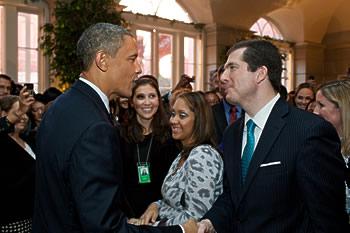Hope for the Best, Plan for the Worst
From his post in the White House, Brian Kamoie ’93 works to keep Americans safe from all manner of disasters
by Sherri Kimmel
President Barack Obama greets Brian Kamoie '93 after delivering remarks at the National Security Council Holiday Christmas Party at Blair House on Dec. 9, 2011. (Official White House Photo by Pete Souza)
The movie Contagion grippingly presents the mayhem that a mysterious lethal virus can level on the people of the United States. Painful, ugly deaths. Lack of food. Breakdown of social order. Convincing as it was, could this really happen?
Though clearly hyped for drama, “the movie conveys the challenges of emerging infectious diseases,” says Brian Kamoie ’93, who from his office in the grand, soaring Eisenhower Executive Office Building, adjacent to the West Wing of the White House, thinks about pandemics of this sort daily. “The central message is we need to be aware of the potential for emerging disease and take steps to prepare ourselves.”
As senior director for preparedness policy for the National Security Staff, Executive Office of the President, Kamoie has been a key strategist in the nation’s response to the H1N1 pandemic in 2009, the Haiti earthquake in 2010, the Deepwater Horizon oil spill in 2010 and the nuclear emergency in Fukushima, Japan, last spring. “Each of the incidents had a lot of uncertainties that created a lot of concern,” he admits.
Besides supporting the response to natural disasters, terrorism, emerging infectious diseases and other threats to the nation, Kamoie helps the Obama administration focus on “how we can make individuals in communities and the nation better prepared. How do we protect critical infrastructure and ensure that it is prepared to withstand disruptions to the electrical grid, telecommunications, transportation—essential lifeline services to the nation? We also do training and exercises to prepare people for their roles in disasters and emergencies.”
While Kamoie may find himself in the Situation Room of the White House with the president for a pre-hurricane-season preparedness briefing or a disaster response or exercise, he’s more likely to advise his boss, John Brennan, assistant to the president for homeland security and counterterrorism, or other senior presidential advisors who then meet directly with Obama.
“Our role is focused on advising the president and his senior staff—working with federal departments and agencies to develop good policy and then managing incidents as they occur,” says Kamoie. “The guiding principle is, hope for the best, plan for the worst.”
Working for the White House, he is quick to admit, is a heady experience. “It’s a long way from Altoona to 1600 Pennsylvania Avenue,” he says with a smile.
Back in his high-school student-council days, Kamoie had already decided to pursue public service. As a Pennsylvania state-legislature intern while attending Dickinson, he further realized “the opportunity that public life affords one to work on challenging issues that matter,” he says.
Student Senate service and majors in policy studies and political science prepared Kamoie well for the next step—a law degree and a master’s in public health from George Washington University (GWU).
Along the way, he married former Student Senate president Laura Croghan ’92, an associate professor of history at the U.S. Naval Academy and romance novelist whose pseudonym is Laura Kaye. Kamoie also made time to serve on Dickinson’s Alumni Council for eight years, two of them as president, and on the Board of Trustees for four years.
James Hoefler, his former political-science professor, appreciates Kamoie’s dual dedication to his nation and his college. “It’s been a joy to watch his trajectory and to keep in touch with this bright and shining alumnus who never lost touch with his school and never missed an opportunity to give back to his alma mater,” Hoefler says.
After practicing health law for a few years, Kamoie taught at GWU, then began government service in 2004, rising to deputy assistant secretary for preparedness and response at the U.S. Department of Health and Human Services. In 2009, he joined the National Security Staff.
“It’s a 24/7, 365-day-a-year operation to support the president and the American people,” Kamoie notes. When he first joined the White House staff, he allowed the demands to overtake him. One day he realized he was too tired to play with his two daughters and faced the fact that he’d gained 80 pounds since his Dickinson days. He immediately joined a 24-hour gym and vowed to change his diet.
Now 90 pounds lighter, he makes sure he hits the gym no matter how late he arrives home. His afternoon pick-me-up is a Diet Coke—though he’ll occasionally snag a handful of red, white and blue M&M’s from the West Wing stash.
Having served under two presidents, Kamoie explains that, as a career senior executive and subject-matter expert, he is not as affected by a change in administration as a political appointee would be.
That being said, “people typically come to the White House and serve for a year or two,” he notes. “The pace and intensity of many jobs in government are such that it is unlikely that people will do it for an entire career.”
When Kamoie moves on, he’ll “seek out a role that allows me to contribute to public life, whether or not that’s in the public or private sector or academia.”
Until then, he admits, “I am in awe every day of walking through those gates [to the White House]. The chance to do meaningful work with exceptionally smart people who are committed to public service is a rare opportunity for which I am grateful.”
Published January 2, 2012